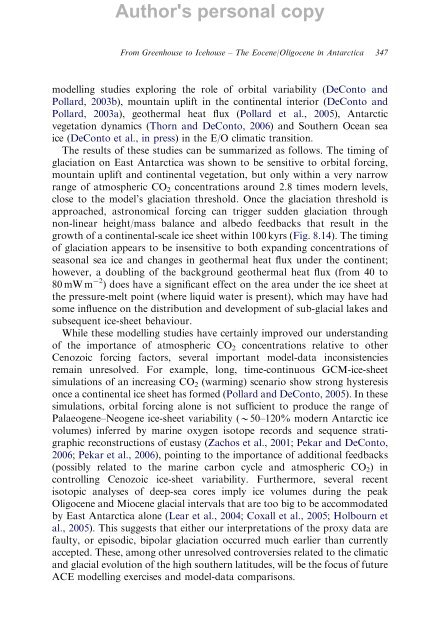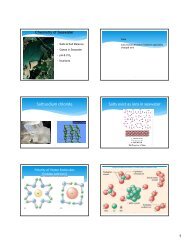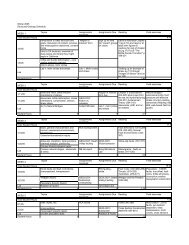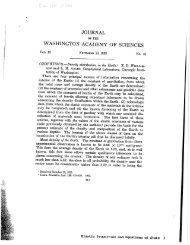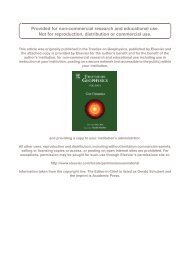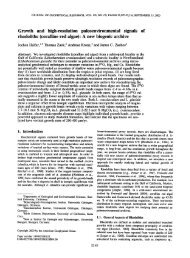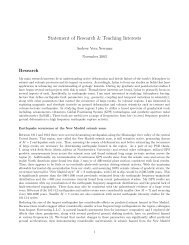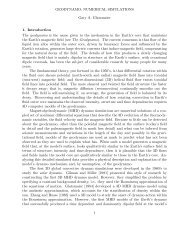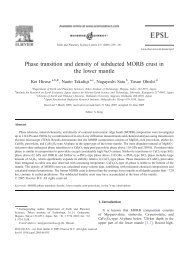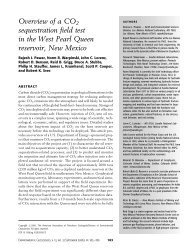From Greenhouse to Icehouse – The Eocene/Oligocene - UMass ...
From Greenhouse to Icehouse – The Eocene/Oligocene - UMass ...
From Greenhouse to Icehouse – The Eocene/Oligocene - UMass ...
Create successful ePaper yourself
Turn your PDF publications into a flip-book with our unique Google optimized e-Paper software.
Author's personal copy<br />
<strong>From</strong> <strong>Greenhouse</strong> <strong>to</strong> <strong>Icehouse</strong> <strong>–</strong> <strong>The</strong> <strong>Eocene</strong>/<strong>Oligocene</strong> in Antarctica 347<br />
modelling studies exploring the role of orbital variability (DeCon<strong>to</strong> and<br />
Pollard, 2003b), mountain uplift in the continental interior (DeCon<strong>to</strong> and<br />
Pollard, 2003a), geothermal heat flux (Pollard et al., 2005), Antarctic<br />
vegetation dynamics (Thorn and DeCon<strong>to</strong>, 2006) and Southern Ocean sea<br />
ice (DeCon<strong>to</strong> et al., in press) in the E/O climatic transition.<br />
<strong>The</strong> results of these studies can be summarized as follows. <strong>The</strong> timing of<br />
glaciation on East Antarctica was shown <strong>to</strong> be sensitive <strong>to</strong> orbital forcing,<br />
mountain uplift and continental vegetation, but only within a very narrow<br />
range of atmospheric CO2 concentrations around 2.8 times modern levels,<br />
close <strong>to</strong> the model’s glaciation threshold. Once the glaciation threshold is<br />
approached, astronomical forcing can trigger sudden glaciation through<br />
non-linear height/mass balance and albedo feedbacks that result in the<br />
growth of a continental-scale ice sheet within 100 kyrs (Fig. 8.14). <strong>The</strong> timing<br />
of glaciation appears <strong>to</strong> be insensitive <strong>to</strong> both expanding concentrations of<br />
seasonal sea ice and changes in geothermal heat flux under the continent;<br />
however, a doubling of the background geothermal heat flux (from 40 <strong>to</strong><br />
80 mW m 2 ) does have a significant effect on the area under the ice sheet at<br />
the pressure-melt point (where liquid water is present), which may have had<br />
some influence on the distribution and development of sub-glacial lakes and<br />
subsequent ice-sheet behaviour.<br />
While these modelling studies have certainly improved our understanding<br />
of the importance of atmospheric CO2 concentrations relative <strong>to</strong> other<br />
Cenozoic forcing fac<strong>to</strong>rs, several important model-data inconsistencies<br />
remain unresolved. For example, long, time-continuous GCM-ice-sheet<br />
simulations of an increasing CO2 (warming) scenario show strong hysteresis<br />
once a continental ice sheet has formed (Pollard and DeCon<strong>to</strong>, 2005). In these<br />
simulations, orbital forcing alone is not sufficient <strong>to</strong> produce the range of<br />
Palaeogene<strong>–</strong>Neogene ice-sheet variability (B50<strong>–</strong>120% modern Antarctic ice<br />
volumes) inferred by marine oxygen iso<strong>to</strong>pe records and sequence stratigraphic<br />
reconstructions of eustasy (Zachos et al., 2001; Pekar and DeCon<strong>to</strong>,<br />
2006; Pekar et al., 2006), pointing <strong>to</strong> the importance of additional feedbacks<br />
(possibly related <strong>to</strong> the marine carbon cycle and atmospheric CO2) in<br />
controlling Cenozoic ice-sheet variability. Furthermore, several recent<br />
iso<strong>to</strong>pic analyses of deep-sea cores imply ice volumes during the peak<br />
<strong>Oligocene</strong> and Miocene glacial intervals that are <strong>to</strong>o big <strong>to</strong> be accommodated<br />
by East Antarctica alone (Lear et al., 2004; Coxall et al., 2005; Holbourn et<br />
al., 2005). This suggests that either our interpretations of the proxy data are<br />
faulty, or episodic, bipolar glaciation occurred much earlier than currently<br />
accepted. <strong>The</strong>se, among other unresolved controversies related <strong>to</strong> the climatic<br />
and glacial evolution of the high southern latitudes, will be the focus of future<br />
ACE modelling exercises and model-data comparisons.


